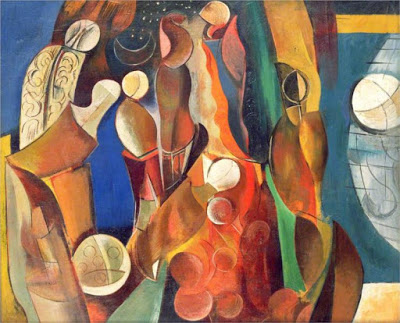by Nina
 |
| Creation Myth by Wyndham Lewis |
There are so many myths about the yoga tradition that get passed on from teacher to student and then to those student’s students and so on. And often these myths even get published in reputable publications. Here’s an example from Yoga Journal Magazine.
Also known as yogic sleep or sleep with awareness, Yoga Nidra is an ancient practice that is rapidly gaining popularity in the West. It is intended to induce full-body relaxation and a deep meditative state of consciousness. “We live in a chronically exhausted, overstimulated world,” says Rod Stryker. “Yoga Nidra is a systematic method of complete relaxation, holistically addressing our physiological, neurological, and subconscious needs.” — Stephanie Levin-Gervasi, “Find Full-Body Relaxation in Yoga Nidra” in Yoga Journal Magazine
The myth above is the part about Yoga Nidra being an ancient practice. Although the term itself is ancient (it originally was just a synonym for the state of deep meditation that we usually called samadhi), the practice that Rod Stryker describes as “a systematic method of complete relaxation, holistically addressing our physiological, neurological, and subconscious needs” is a modern practice. And the rest of the article Find Full-Body Relaxation in Yoga Nidra is a confusing mishmash of modern Yoga Nidra with ancient descriptions of meditation. (My source for my understanding of the myth vs. reality above is the paper “YOGANIDRA: An Understanding of the History and Context” by Jason Birch and Jacqueline Hargreaves.)
Unfortunately, many of the myths that continue to be circulated are about quite important issues, including that Patanjali’s Yoga Sutras was the most important text on yoga in India and for Ashtanga yoga that the primary series was discovered in an ancient manuscript. Although myth busting isn’t one of my main goals for this my work on this blog, when I’m writing about a topic that has myths associated with it, I do try to separate myth from fact. And it this takes quite a bit of research, I can tell you. But my independent yoga studies (which are ongoing), particularly the books The Yoga Body by Mark Singleton, The Yoga Tradition at the Mysore Palace, by NE Sjoman, and The Yoga Tradition by Georg Feuerstein, have led me to be suspicious about many claims I hear. Then, when I’m suspicious, I look a bit deeper into the subject.
Because Jivana and I just went down a rabbit hole together regarding the origins of Yoga Nidra (a place I’ve been before but because he was questioning me I wanted to double-check just in case), I started to think about why this matters so much to me. In some cases, believing a myth can lead to actual harm. For example, the myth that the Ashtanga primary series is an ancient and perfect practice (rather than a beautiful yoga performance piece choreographed by Krishnamacharya and Jois to show off the asana practice as form of advertising the practice) has surely led to a large number of physical injuries. But how does it hurt people to believe that Yoga Nidra is an ancient practice when it was actually developed in the 20th century by Swami Satyananada (see Friday Q&A: What is Yoga Nidra?) or that for centuries in India the Yoga Sutras was a relatively minor work and it was Swami Vivekananda who popularized it in the west in the late 19th century?
In general this whole habit of believing concepts and practices are ancient and therefore perfect can lead to a lack of questioning, which is never a good thing. And while some of these myths may have arisen from lack of understanding (the fact that there was an ancient term “yoga nidra” could have led people to become confused about how that term related to the modern Yoga Nidra practice), in other cases, some were intentionally fostered to make a practice more “legitimate” and possibly less open for debate.
But more importantly the truth matters. And from the very beginning of this blog, we committed to being fact-based in our discussions about aging, science, medicine, and yoga. So when there are things for which we don’t have proof we are honest in saying that we are drawing conclusions from our personal experience or from anecdotal evidence. This practice of being truthful and fact-based in our writing actually takes a lot of behind-the-scenes work on my part as I do fact checking on posts written by others via my own research and discussions with Brad when I notice something that seems scientifically sketchy to me.
And for yoga history and philosophy, I’m attempting to apply the same kind of rigor. I try to be as accurate as possible and if learn a practice is actually modern or a philosophical concept is just a modern interpretation of ancient idea that was quite different, I will say so. And when I find errors in a post after the fact, which I often do as I continue to educate myself, I will go back and correct them or ask the original author to do so (as I did with Baxter and his post on avidya, ignorance, which you can see at Richard Rosen Clarifies the Meaning of Avidya).
I must admit this self-assigned commitment to truth feels a bit overwhelming at times, and I fear that I often miss important things. But I tell myself I will just try my best. And that’s my promise to you as well as to myself.
Follow Yoga for Healthy Aging on Facebook ° To order Yoga for Healthy Aging: A Guide to Lifelong Well-Being, go to Amazon, Shambhala, Indie Bound or your local bookstore.


It is little known that Krishnamacharya invented many of the poses used in Iyengar, Vini, and Ashtanga yoga. He ran a school for young men from the military. He combined calisthenics with western acrobatics and his own interpretation of yoga to devise workouts for his students who of course were extremely fit young men. Many believe that the ancient sadhus were doing sun salutations in their caves.
The implication that Yoga Journal is a reputable publication is something of a myth itself.
Thanks Nina. I very much appreciate your efforts to clarify what is factual. I think it's an important avenue to pursue so that we can teach and practice with integrity. For a long time I've been wondering if the Yoga Sutras were were considered an important work before the late 19th century. I've always been struck by how it's used as such a seminal text but seems to be often taught very much out of context.
I'm surprised at Nina's aversion to Yoga Nidra. Somatic meditation is not unique to yoga. I practice irest, a form of Yoga Nidra, daily with great benefit. Why such hostility beyond her aversion to "sketchy science" and allegations of sexual abuse by a teacher? Please check out irest.
You have misunderstood me! I was not expressing an aversion to Yoga Nidra per se (and certainly not to iRest) but rather to claims that it is an ancient practice. And, yes, I have an aversion to sexual abuse by the founder and his circle–that should not be surprising. In my post on the topic, I quoted Richard Miller at length, so obviously I have no aversion to him or to iRest. My aversion to "sketchy science" is just a general one regarding any scientific or medical claims by anyone, and had nothing to do with iRest or Yoga Nidra.
There is also research on irest documented on the irest website.
I feel sad that you aren't publishing my comments and that your posts may prevent others from experiencing the benefits of Yoga Nidra. I'm so disappointed by your response or lack of response.
Sorry, I was a bit concerned your first comments were spam (which I often get).
she is NOT saying yoga Nindra does not have benefits, she is saying that it is not an ancient practice. Just because something is not ancient does not mean it does not have benefits. That was the point. in my mind if it works do it. Who cares when it was invented.
Hi, Nina,
I rarely write in response to blogs, but in this case I was sad – it was quite an example of how tearing down another makes one feel more righteous, and I see this so much in some schools of yoga. I have a doctorate in psychology based on the study of the YS and the Samkhya, and years studying sanskrit and history, so I have an academic and clinical background. I'd ask you: Consider what writing an article like this does for you, really. Can you use your forum for appreciation rather than criticism? The debate you spark is just another fluctuation, isn't it?
Thanks for weighing in! I actually think the debate I'm sparking is very important. Many people have been thanking me both publicly and privately for raising these issues and standing up for truth vs. myth And I don't at all feel like I'm tearing anything down to make myself feel righteous. I love yoga and have been practicing for many years and have written three very positive books about it! But I don't see how staying silent about false claims that can actually be harmful would serve either myself or others. I'd like to ask you: did you find it sad that people like Georg Feuerstein, Mark Singleton, and Richard Rosen dedicate themselves to writing accurate histories of yoga? If not, why is it sad that I'm sharing their ideas?
When people feel "right" they tear down others, isn't that true? I've read both both the Western and the many Indian authors and philosophy, and I teach this topic. I am cognizant of the consensus of historical fact and the interpretations. I think what I would like to say to you is that one of the things yoga can offer is understanding and inclusions. There is no getting it right. Mythology is a story of personal and collective experience — we've fought wars because my tale wasn't the same as your tale. So tell people about what you learn, not how the other is wrong. Debate IS just another way for our minds to go to judgement.
The term "false claims" is quite subjective though, isn't it? I helped edit Rod Stryker's ParaYoga Nidra manual with him and it was such a pleasure to read through ancient texts that make mention of the practice of yoga nidra. The latest text we've been studying that refers to yoga nidra is Adi Shankara's Yoga Taravali, from the early 8th century. Sure, the methodologies in use today could be considered "new" because methodologies weren't really recorded back then, they were passed down orally from teacher to student. And of course methodologies can and do evolve over time, much like languages. But that wouldn't make me jump to the conclusion that it's therefore not an ancient practice. That would be like saying yoga is "new" because I'm hanging upside down on a yoga trapeze, and they just weren't doing that thousands of years ago :)
I can say, however, that the practice––when I experience it––doesn't feel based on a false claim; au contraire, I feel like I am experience a deep stillness and state of being that is steeped in tradition.
Despite arguments about origins and allegations of sexual abuse in a teacher I hope no one will be detered by this site from trying yoga nidra. I've been practicing daily for several years with great healing benefit. It would be unfortunate if others missed out on the gifts of this practice.